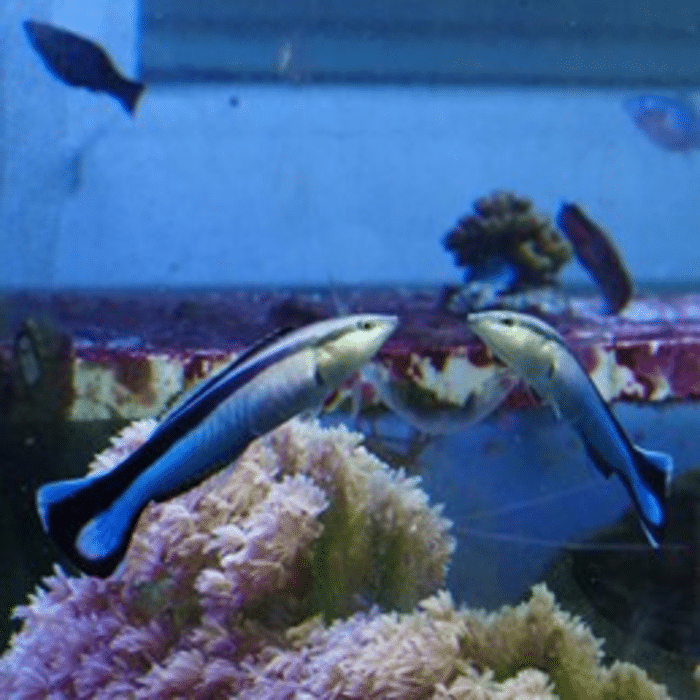

The common cleaner wrasse recognized itself as the first fish in the world in the mirror. And now he passes the formidable mirror test again.
A few years ago, researchers made a great discovery. The common cleaner wrasse – a tiny fish that is about as big (or small) as a human finger – was allowed to join the prestigious list of animals that pass the mirror test. Still, not all scientists were convinced. But now the researchers provide additional evidence that the tiny, tropical fish is actually able to recognize its own reflection.
The mirror test is a test to determine whether animals recognize themselves in a mirror. In this test, an animal is unmarked with a spot or dot on the body. The animal is then placed in front of a mirror, waiting to see if it has noticed the spot. If the animal tries to touch the dot, or tries to take a closer look at the spot, it can be concluded with some certainty that the animal recognizes itself in the mirror. Animals that have already passed this test include chimpanzees, dolphins, magpies and elephants.
The fact that the common cleaner wrasse passed the mirror test in the previous study was a huge breakthrough. It was the first fish in the world to recognize itself in the mirror. In addition, the findings suggested that the common cleaner wrasse is self-aware, despite fish belonging to a group thought to have lower cognitive abilities.
Criticism
But the study was harshly criticized. For example, scientists did not find the evidence convincing enough. In the study, the researchers put a brown spot on the throats of some common cleaner wrasses, which were swimming around in a tank with a mirror. Three of the four fish then, after spending some time in front of the mirror, rubbed the appropriate spot against objects. From this, the researchers concluded that the fish recognized themselves in the mirror, which would indicate self-awareness. One of the criticisms, however, was the small sample size. Moreover, for such large claims, the study should actually be repeated first, critics argued.
brown spot
The researchers are now responding to this. In the new study, they tested 18 common cleaner wrasses. Again they placed a brown spot on the throat of the fish. Why a brown spot? “This looks like a small parasite, which is an important food source for the common cleaner wrasse,” explains study leader Masanori Kohda. This time, however, the team set the dot just a little lower than during the first study, making it a bit more difficult to see and challenging the fish even more.
Different tanks
In addition, the fish were tested in different tanks with mirrors. This is to confirm that the common cleaner wrasse really recognizes its mirror image as itself and does not mistake it for another fish. Why different tanks? Each animal that passes the mirror test actually goes through three steps. At first they show quite aggressive behavior and try to attack themselves in the mirror. Then it slowly starts to dawn and they show striking and sometimes even strange behavior in front of the mirror. For example, the common cleaner wrasse began to perform short dances. And finally, the animals try to brush away the stain that the researchers put on their bodies. By placing the fish in a new tank with a mirror after they had gone through all the steps, it was possible to check whether they once again mistook their reflection for a stranger, or whether they had recognized themselves in the meantime.
Successful
The researchers make an interesting discovery. Because once again the vast majority of the common cleaner wrasses in the study passed the mirror test. No fewer than 17 of the 18 fish (94 percent) successfully passed the formidable test. For example, not only did they try to brush off the placed brown spot, when the fish were transferred to a new tank with a mirror on one side and three days later to a tank with a mirror on the other side, the researchers found that the fish none of the tanks showed any aggressive behavior towards their mirror image.

An ordinary cleaner wrasse sees itself in the mirror. Image: Masanori Kohda
According to Kohda, the findings are indisputable. “It is very clear and no doubt that common cleaner wrasses recognize themselves in the mirror,” he said in an interview with Scientias.nl† “The fish paid close attention to the brown dot and eagerly tried to remove it. Many other fish do not exhibit such behavior. It means that the common cleaner wrasse has passed the test.”
Self awareness
By the way, according to Kohda, that does not mean that other fish are not self-conscious. “I think many other animals and fish have a sense of self,” he argues. “Only they fail the mirror test.” Why the common cleaner wrasse can do that is possible because these fish have good eyesight. They spend a lot of time looking for parasites on other people’s bodies. “The common cleaner wrasse has a specific motivation to pay attention to the dot,” Kohda said. “However, we are now working on other fun methods to find out whether animals are self-aware. I’m pretty sure many fish can recognize themselves in the mirror. I think most fish have some form of self-awareness.”
The findings have far-reaching implications. “It suggests that high cognitive ability, such as recognizing yourself in a mirror, is not limited to humans and great apes, or large-brained animals,” Kohda concludes. “It is probably common in a wide variety of animals; more than is currently thought.”
Source material:
†Scientists persevere to show self-awareness is also for some fish” – Osaka City University
Interview with Masanori Kohda
Image at the top of this article: Karelj via Wikimedia Commons